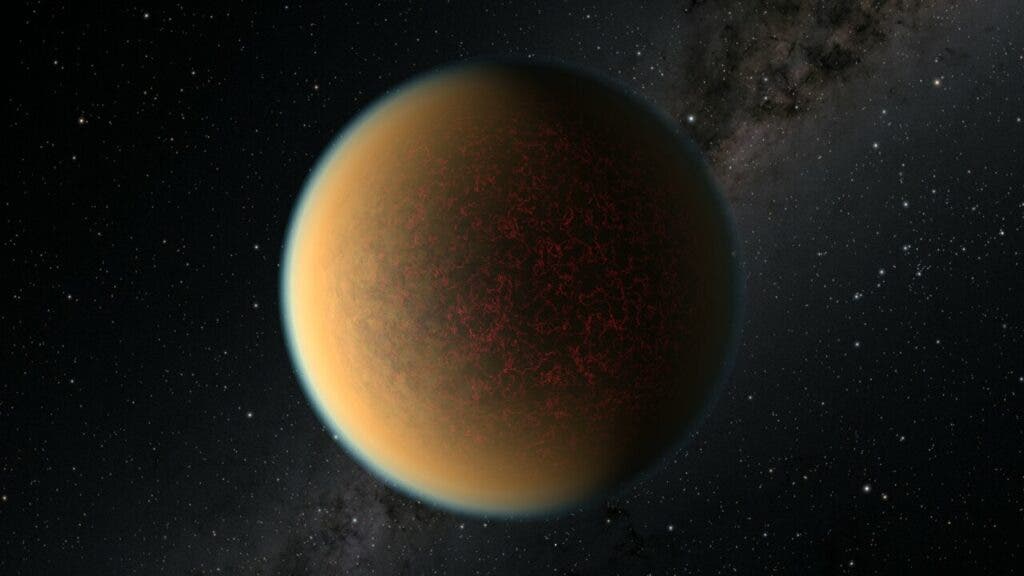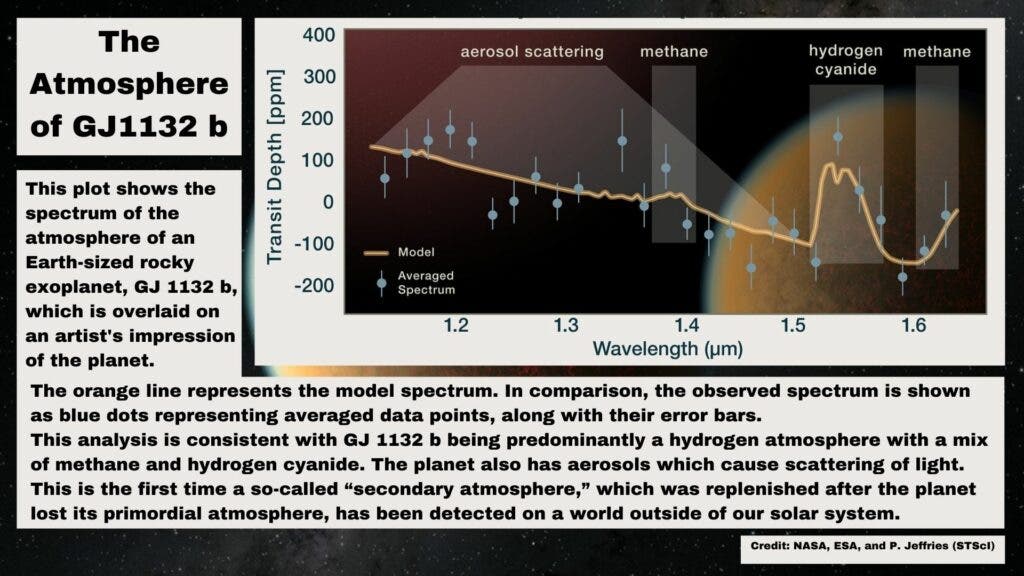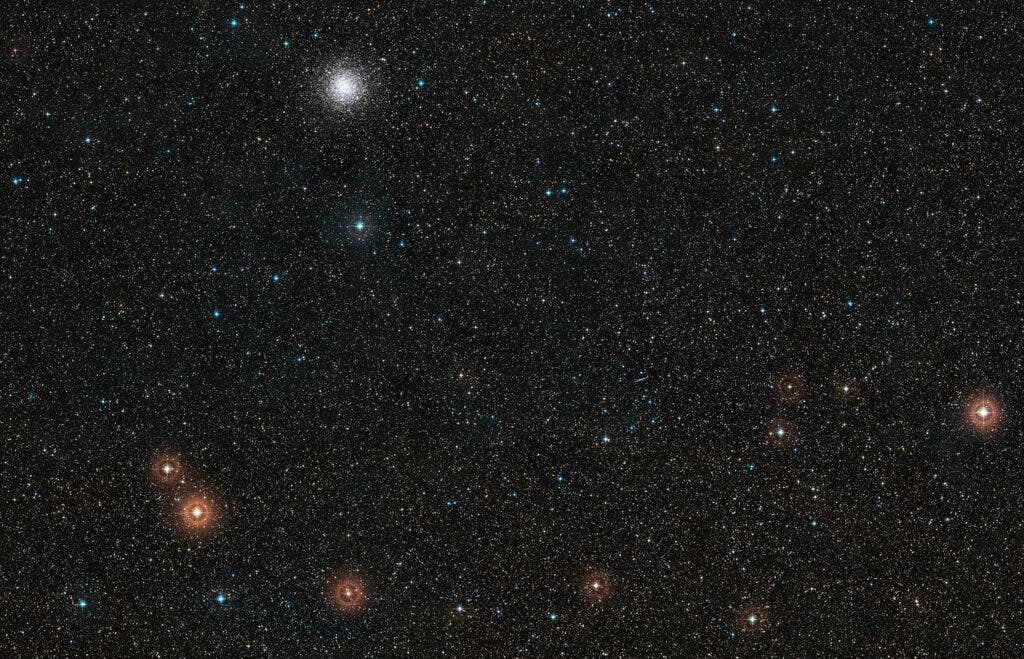Using the Hubble Space Telescope astronomers have spotted an important and extraordinary event in planetary evolution for the first time. The researchers have observed volcanic activity on a distant rocky planet reforming that world’s atmosphere.
The planet–GJ 1132 b–is believed by the team to have previously possessed an atmosphere that was stripped by the intense radiation emitted by the bright young red dwarf star it closely orbits. After its thick blanket of hydrogen and helium was expunged the planet was left as a rocky core roughly the size of Earth.

The astronomers believe that much of the hydrogen from GJ 1132 b’s initial atmosphere was absorbed by the exoplanet’s molten magma mantle creating a reservoir of the element which is now being slowly dispersed back into the atmosphere. This dispersal replenishes hydrogen being lost to space.
The fact that the planet’s volcanic activity is generating a secondary atmosphere that is replacing the first has come as a huge suprise to the researchers.
What makes this replacement atmosphere so interesting and useful to astronomers is the fact that has come from the planet’s interior. Thus its chemical composition–with abundant hydrogen, hydrogen cyanide, methane and ammonia with glimmers of a hydrocarbons–means that astronomers should be able to study the interior of the exoplanet by proxy.
“This second atmosphere comes from the surface and interior of the planet, and so it is a window onto the geology of another world,” explains Paul Rimmer, University of Cambridge, UK, who was part of the team that made the discovery. “A lot more work needs to be done to properly look through it, but the discovery of this window is of great importance.”
The finding could change the way we think about highly irradiated exoplanets which astronomers normally expect to lack atmospheres. “We first thought that these highly radiated planets would be pretty boring because we believed that they lost their atmospheres,” explains Raissa Estrela of the Jet Propulsion Laboratory at the California Institute of Technology in Pasadena, California, USA, another member of the research team. “But we looked at existing observations of this planet with Hubble and realised that there is an atmosphere there.”
Like Earth, But Really Different
Whilst sharing some similarities with Earth, GJ 1132 b is actually a very different world. GJ 1132 b has a similar density, size and age–around 4.5 billion years. Additionally, both planets started life as molten balls of rock with hydrogen-dominated atmospheres. But, whereas our planet was able to hang on to its atmosphere, the intense radiation GJ 1132 b was exposed to stripped that world’s gaseous envelope.
The differences become more extreme when considering the formation of both worlds. GJ 1132 b is the surviving core of a sub-Neptune exoplanet–a planet resembling Neptune but with a smaller mass–so didn’t start its life as a terrestrial world like we believe Earth did. Possibly the most extreme difference between the two worlds, however, is their relationships with their respective parent stars.

Whilst Earth orbits the Sun at a comfortable distance, rotating on its axis as it does so, GJ 1132 b orbits its red dwarf parent star in blisteringly close proximity. So-close that the exoplanet’s orbit period is just 36 hours. That isn’t the only major orbital difference, however. GJ 1132 b is tidally locked, meaning that the same face points towards its parent star throughout its orbit.
This isn’t the only source of heating the exoplanet is experiencing. The tidal force that the planet experiences due to its proximity to its parent star and that star’s gravitational force is permanently stretching and squeezing it.
This deformation is converted to heat beneath the planet’s surface, maintaining its mantle’s molten state. It could be this tidal heating that is driving the extreme volcanism and also causing the planet’s thin crust to crack, allowing hydron to escape and replenish the atmosphere.
The findings raise the question; how many of the terrestrial worlds we see are actually the stripped cores of sub-Neptunes?
“How many terrestrial planets don’t begin as terrestrials? Some may start as sub-Neptunes, and they become terrestrials through a mechanism whereby light evaporates the primordial atmosphere,” says Mark Swain of NASA’s Jet Propulsion Laboratory who led the research. “This process works early in a planet’s life when the star is hotter. Then the star cools down and the planet’s just sitting there.”
“So you’ve got this mechanism that can cook off the atmosphere in the first 100 million years, and then things settle down. And if you can regenerate the atmosphere, maybe you can keep it.”

Acknowledgement: Davide De Martin)
The observations made by the team were part of the Hubble observing program and raise the interesting possibility that if this secondary atmosphere is thin enough, astronomers could actually see down to the surface of the exoplanet.
“This result is significant because it gives exoplanet scientists a way to figure out something about a planet’s geology from its atmosphere,” concludes Rimmer. “It is also important for understanding where the rocky planets in our own Solar System — Mercury, Venus, Earth and Mars, fit into the bigger picture of comparative planetology, in terms of the availability of hydrogen versus oxygen in the atmosphere.”









